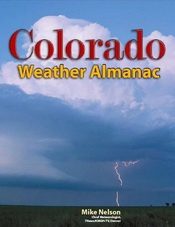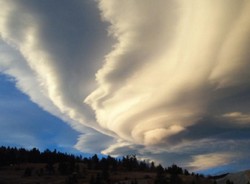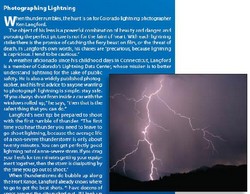
The Colorado Weather Almanac came out last year and I have added this to my short list of “must read” books for anyone interested in weather, particularly for those in Colorado. Everyone here in Colorado is well aware of the author, Mike Nelson, 7News’ chief meteorologist, and he does an extraordinary job covering the entire gamut of weather conditions we receive here.
The best part of the book is described in one of the words in the title – Colorado. This is all about our weather. It starts out with what is probably in my opinion the single most interesting section, Colorado climate. Mr. Nelson explains all the ins and outs of how our topography and our geography greatly impact the weather we have and why weather varies so greatly over short distances, even within the confines of the metro area and Front Range.
There is of course discussion about standard weather terms we all have heard such as dew point, pressure, fronts, El Nino, La Nina and on and on. The key though is that the book ties all of this into Colorado and how these things directly impact us. Other terms associated with our weather like upslope, downslope, Chinook and more are also covered; things that we hear on the news every day but may not fully understand.
The book then moves into a discussion of the cold and warm seasons in Colorado and the weather patterns and hazards associated with them. From the Fall and the Aspen turning colors to Winter and the snow and sometimes bitter cold, it is all covered. As the discussion turns to summer, topics such as thunderstorms and hail, tornadoes, flooding and fire danger are all included.

The book brings to the forefront a lot of weather history from Colorado’s earliest days as a state and even talks about the early forecasters and the establishment of the National Weather Service office in Denver. We all remember significant weather events – they are a part of Colorado history and the book covers a number of them from the start of the 20th century forward. From major snowstorms in 1913 and 1921 to the Big Thompson Flood and the Christmas Eve Blizzard of 1982 to more recent events like the Storm King Mountain Fire, the drought we recently emerged from and the Holly tornado, they are almost all here. I do wish the Thornton tornado of 1981 had been discussed not only because of its significance to Thornton but also because it was one of the very few tornadoes to strike the Denver metro area.
There is ample discussion about tornadoes in general, how they form, why Colorado is a hot bed of activity – we are after all at the western edge of Tornado Alley – and other significant tornadoes that have happened in the state. Other severe summer weather such as hail and lightning receive equally in depth discussion. Ever thought about storm chasing? The book even has a great primer on the topic as well.
Any discussion of weather these days naturally also includes a discussion of climate change and the book does include a chapter on the topic. Whether you are a believer or a doubter, the section does provide a good discussion of it and for the most part refrains from preaching too much.
The book closes with a section on weather forecasting and considering who the author is, it of course includes a good dose of what all goes into making a TV weather broadcast. More than that though, a thorough discussion of the technology behind it all from the computers to radar and the infamous green screen are included. Most interesting is a bit of a historical lesson on the first TV weather broadcasts.

The book itself is beautifully illustrated with hundreds of photos and charts and tables. In fact, the illustrations were all done by the students at Front Range Community College in Westminster. They are all very detailed and provide a great visual reference to the topics in the book.
One less noticed aspect of the book but also one of the more notable is the many sidebars throughout the book. These contain fascinating and educational information and trivia related to the topic that is being discussed in the main text and could almost be a book unto themselves.
For selfish reasons I would have liked to have seen mention of the many “amateur meteorologists” like me that run personal weather stations. There are hundreds of these across the state, many with websites like ThorntonWeather.com and they provide a service to not only their home communities, but also to professional meteorologists and are even used by National Weather Service forecasters. A brief sidebar talking about these and how an average Joe can get involved in the hobby for minimal cost would have been a nice addition, perhaps in one of the sidebars.
In the end, The Colorado Weather Almanac is a great book for anyone interested in Colorado weather and I really cannot heap enough praise on it. Mike Nelson covers virtually every topic a weather watcher could want to know about and does so in a way that is easy to understand for the layman while still providing enough depth that a seasoned weather watcher gets something out of reading it. This is quite simply the best book around about Colorado weather.
For more information:

This is indeed a great book for those interested in Colorado weather. The climate here is so unique that this helps you understand why (and maybe even feel a little sorry for the weather forecasters when they get it wrong).